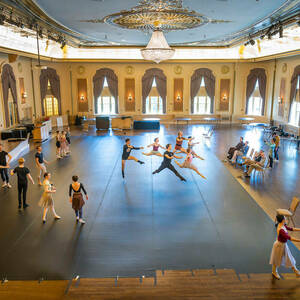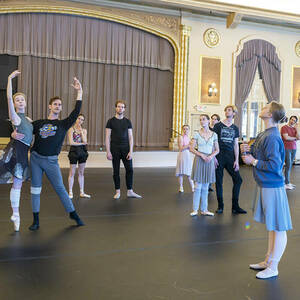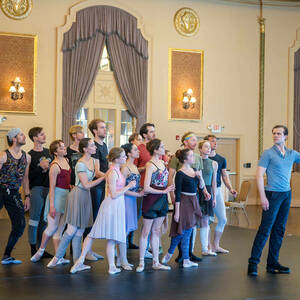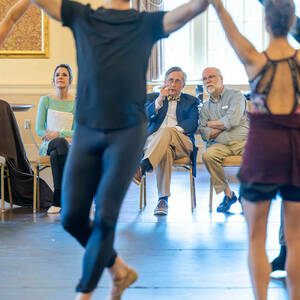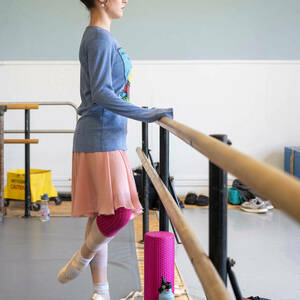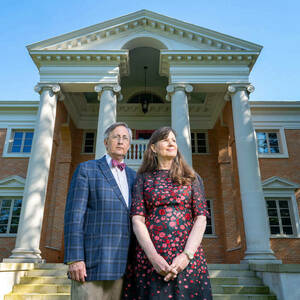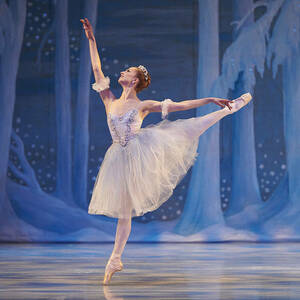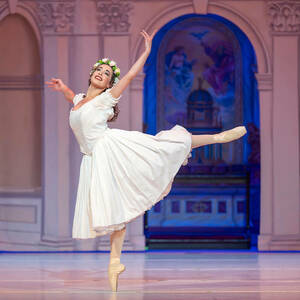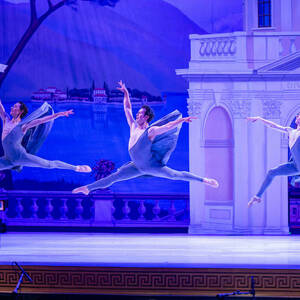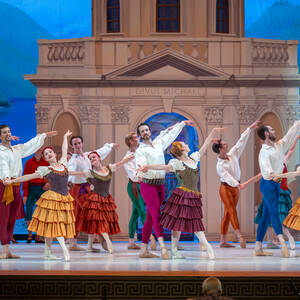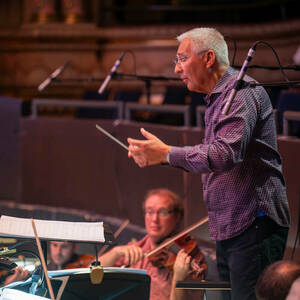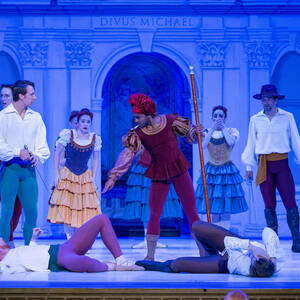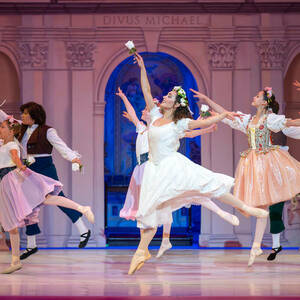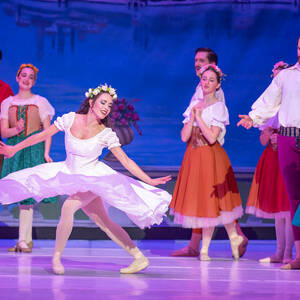 Photo by Barbara Johnston
Photo by Barbara Johnston
- A Fairy Tale for Raffaella
- Raffaella, Aloft
- Stories Unspoken that Steal Your Heart
In a serene, skylit atrium, the heart of a four-columned Greek temple of a home that gazes northwest across Lake Michigan, a mother’s voice catches as she tries to answer an unexpected question.
What was it like to watch your daughter dance?
Within an instant, the mother’s heart gathers in a 23-year span that was unequal parts fairy tale, tragedy and ordinary life, a life that ended far too soon.
It reaches out beyond the last time she saw the young woman dance as a professional with the St. Louis Ballet; past her emergence as a ballerina at Indiana University; down through so many childhood Novembers preparing The Nutcracker for hometown audiences at South Bend’s Morris Performing Arts Center. And it alights on a single scene, the Waltz of the Flowers, performed many, many years ago at another theater in another town.
Raffaella was leading the trio. “And I was sitting with all the mothers,” Ruth Stroik says, her voice gentle, recollecting, springing lightly over details. “It made me cry. I looked over, and the other mothers were crying, too.”
When she danced, Raffaella Stroik connected with people. It was a form of prayer for her. She felt joy and love she wanted to share. It is that simple.
Ruth is not a dancer, but she understood her daughter, the second oldest of her six children, the miracle baby who arrived after five miscarriages — who waited for her father the architecture professor’s semester to end at Notre Dame before she appeared, finally and happily, on a rainy morning in December 1994.
The architect, Duncan Stroik, who would soon make his name as a leader in the revival of Catholic sacred architecture, and his wife the fine artist — a plein-air painter in oils, and a teacher in her own right — named their daughter for one of Ruth’s heroes, Raphael Sanzio, the Renaissance master, but all the more for the angel Raphael, the healer, the protector of pilgrims. When Raffaella was born after so many years of pain and disappointment, her mother felt healed.
In the years that followed so swiftly, Ruth observed everything about Raffaella just as she did with all her children; knew her aspirations, her heart, her struggles and flaws, in life and on stage.
“So, Raffaella, she didn’t have perfect feet as a dancer,” Ruth recalls. Back then, the girl knew it, her instructors knew it, competition judges always knew it. “She had sort of a natural thing where her feet turn in, which is the opposite of what you want as a ballerina, but . . . she really worked at correcting her feet.” And beyond this commitment, beyond her devotion to dance as an art form, Raffaella had this other thing, too.
One teacher called it “performance quality,” and it was a striking paradox for a girl whose other great artistic nemesis was a natural aversion to the spotlight.
Ruth puts it differently.
“She felt spiritual when she was dancing, and she wanted to connect that to the audience.”

At some time in the late morning or early afternoon of Monday, November 12, 2018, Raffaella Maria Stroik drowned in the lake at a Missouri state park about a two-and-a-half-hour drive from her home in St. Louis. She was alone.
Approaching her 24th birthday, embarking on a new performance season in a profession she loved, the young woman also had been contemplating a religious vocation and had discussed it with her mother many times. “She was on a day of recollection by herself. She loved to go off and walk by herself, to think and pray — a true artist in her love of solitude,” her father says.
Raffaella had taken the day off work and been seen that morning at a suburban grocery store buying provisions for a hike. The weather, notably warm earlier in November, had turned sharply cold. No stranger to bitter elements, the South Bend native had prepared herself by layering with long underwear and a down vest and parka.
A call from local police the next day informed Ruth that a car registered in her name had been left in the park overnight. The Stroiks drove to Missouri, spent the night searching for their lost girl in temperatures that had dropped into the teens. Ruth recalls shining her flashlight into the woods to find only the deer who were watching her.
“And I had this immediate sensation,” Ruth says. “I felt her in the sky.” Tangible. Real. As if Raffaella wanted to tell her what happened, wanted to share her joy — that she was free. “And I remember going, ‘No, I’m still looking for you.’”
At 9 the next morning, more than a hundred people turned out for the day’s search. Many were friends from St. Louis. Right away, a pilot flying a private plane spotted Raffaella’s body at the water’s edge, a mile opposite the metal docks that stretched into the lake from near the spot where she had parked her car. Her hat was still on her head.
The police ruled out foul play, and the detective’s final report, which the Stroiks received in St. Louis four months later, noted a surprising ice storm that Monday afternoon, a squall that delivered 40 mph winds and whiteout conditions. A park ranger had told Ruth the snow was so dense he could see no more than a foot ahead.
In their grief, Duncan and Ruth Stroik had already determined to do something to honor their daughter’s life — a statue of St. Raphael perhaps, or a fund for aspiring ballerinas. But on the morning they met the detective, Ruth lay in a hotel bed thinking about Raffaella. “And I said to Duncan, ‘Raffaella’s life is like a ballet,’” she recalls. She could think of echoes from Sleeping Beauty, from Serenade, La Esmeralda, Giselle. Even Swan Lake. “And Duncan said, ‘That’s it. We’ll do a ballet.’”
Which isn’t what his wife had meant at all.
But before she knew it, he had called the IU School of Music and received pledges of support. And one year after Raffaella’s death, over the reluctance of his “very shy, quiet” wife, Duncan Stroik launched a GoFundMe account to raise money for the production of a full-length, fairytale ballet inspired by their daughter’s life and carrying her name.
Raffaella. A new ballet in two acts and 14 scenes.
For nearly half of May and all of June 2024, an ad hoc company of some 50 professional and amateur dancers of all ages gathered in South Bend during ballet’s off-season. Together they rehearsed five days a week for something the world hasn’t seen in a long time: a brand-new, narrative ballet with an original story, music and choreography. “It’s just not done today, to this kind of degree, as it used to be decades ago,” says Claire Kretzschmar, a former soloist dancer with the New York City Ballet — the company founded and made famous by the great George Balanchine — whom the Stroiks hired to design the dance.
“It just isn’t done.” That’s a refrain Duncan Stroik says he’s heard countless times in the five years since he stepped into a role he never expected to play in life, that of ballet producer, and determined to prove otherwise.
Ballet in the 21st century, like many performing arts, is in something of a fight for its life. “I think it’s often a misunderstood art form, and I think it sometimes feels a little bit irrelevant in today’s world,” says Isabella LaFreniere, a NYCB principal dancer who was one of Raffaella’s close friends from childhood on, and who was preparing for the ballet’s title role until she sustained an injury.
Even as she’s given her body to 12-hour days, sore feet and a routine choice between Epsom salt or ice baths, LaFreniere has watched as her own company and other arts institutions have schemed to “get this younger generation off of electronics” and into their venues. “There’s just so much at our fingertips that it feels easier and less expensive to do these other things than sit down and have this once-in-a-lifetime experience in the theater,” she concedes.
“Even if people have big ideas, they might not have the infrastructure or the financial or logistical support to make them happen, even on a small scale,” adds Kretzschmar, who in retirement from performance has staked out a career in arts entrepreneurship, creating podcasts and community arts opportunities while testing out her gifts as a choreographer on compositions like Benjamin Britten’s A Ceremony of Carols.
So, the dancer, the choreographer, the composer Michael Kurek — recently retired from the music faculty at Vanderbilt University — and their companions on the ballet’s elite production team, which includes guest conductor Robin Fountain and the South Bend Symphony Orchestra, are placing a kind of wager on beauty, executed on a grand scale and underwritten by the Stroiks’ grassroots fundraising campaign. As of this writing, the effort had collected nearly $375,000.
“It’s really for everybody,” Duncan says of the ballet that premiered June 29 and 30 at the Morris. “We want it to be a broad audience, and a story they’ll appreciate. And it won’t be esoteric, but it will be romantic. . . . It’ll have a fight scene, because we’re counting on half the audience being men.”
Ruth Stroik, her gratitude getting the better of her embarrassment at all the attention, says that whenever the odds against Raffaella seemed impossible, she thought of a high school friend of her daughter’s, now a schoolteacher herself, who has given “a little bit of her paycheck” to the ballet every month.
“It will be beautiful,” says Kretzschmar. “I think this is a huge deal in the ballet world.”

Set in the make-believe Italian village of San Michele during the 18th century, Raffaella is the story of a girl born to dance, welcomed at birth by a mysterious holy man and a transcendent prince, who is invisible to everyone but the child and the audience.
She meets friends and guides, she encounters trials: an enchantress who tries to kidnap her, a near-accident from which she saves a younger sister, the scorn of jealous rivals and threats from other agents of deception. Each moment evokes struggles from his daughter’s earthly life, says Duncan Stroik, and though many episodes are presented with heightened emotion, they point toward essential human hardships to which audiences might relate.
“It’s very much about growing and becoming a better person in a lot of ways, the journey of life,” says Raffaella’s older sister, Gabrielle Stroik Johnson ’13, an architect who designed the ballet’s bi-level sets inspired by Italy’s great colonnaded piazzas and period paintings of Lake Como and Rome’s Piazza del Popolo.
“Fairy tales have sort of a law unto themselves,” explains Kurek, the composer, whose Symphony No. 2, recorded in 2022, is subtitled Tales from the Realm of Faerie. “They operate within aesthetic, moral boundaries, and yet with incredible imagination, but they also are often allegorical,” which makes them relatable, he says. “For me, writing music is allegorical, or is a metaphor for language, for relationships.”
Raffaella the character faces real choices between good and evil, just as Raffaella Stroik did in life. “She was a human being,” Duncan says. As a child, his “Baby RaRa” was placid, happy, kind, “mommy’s helper.” Ruth worried that adolescence would steal this sweetness. It did not. But Raffaella had her dislikes at school and at home. Yes, she did save her youngest sister from being hit by a car during a bicycle ride on a family vacation. And she had a way of hugging with her heart, her mother says. Friends called it “the Raffa hug.”
She also spent long hours on her bedroom floor as a teenager watching ballet videos on YouTube. And once, when a conflict between violin lessons and dance rehearsals forced her to make a hard choice, she stomped her foot so hard that she broke a toe. “And so I thought, this is either a sickness or really serious,” her father says of such enthusiasm.
It was serious. An avid reader of fairy tales, Harry Potter, Jane Austen, The Lord of the Rings and Dostoevsky, Raffaella concluded that “beauty will save the world.” It became her motto.
And the last time they had dinner together, after she danced in Romeo and Juliet, she told her father that for her, dance was beauty. “It’s the beauty of God,” she said, “and I want to share that with other people. I just feel like that’s my goal.”
It was November 3, 2018, a time of prayer for souls journeying to heaven. The day after the Feast of All Souls.

“Beauty will save the world.” In Latin, the phrase translates to Pulchritudo mundum salvabit, words chiseled into the stone above the door of the house Duncan Stroik designed for his three-generation family on a bluff above Lake Michigan. When Raffaella died, the Stroiks considered scrapping their plan to build a retirement home where they could host their grandchildren.
Then they thought better of it. The home became another way to celebrate their daughter’s short life. Each room in Villa Raffaella is themed for one of the ballets in which she danced. The chandeliers in the blue-hued kitchen that gives the best views of the lake are cast in the form of swans.
“I wish we didn’t have to do this ballet. I wish that my sister was here,” says Johnson, who danced with her longtime roommate and best friend for 10 years and often did her hair and makeup before performances. “That being said, I hope I can contribute to making it beautiful.”
“Salvation is definitely a great word,” adds Kretzschmar, contemplating the meaning of the Hebrew word, rapha’. “But I also think maybe an even more singular word to associate with this ballet is a ‘restoration.’ And a ‘healing.’”
“If this ballet has any success,” says Duncan Stroik, “it will touch people to say, ‘New ballet can be beautiful, and regular people can like it.’” And maybe some dancers and companies will add, “We’ll do our own fairytale ballet.”
“That’s what I’d love to see,” he says. “And I think Raffaella and the angel Raphael would agree with me.”
John Nagy is managing editor of this magazine.
